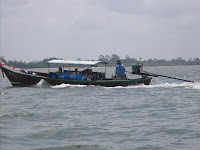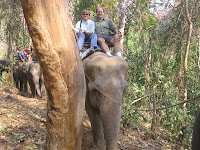March 9.10.11, 2009
Chiang Mai, Thailand
Aranyapathet-Poipet Border Crossing
Siem Reap. Cambodia
Angkor Wat, Cambodia
After another day of wandering through Chiang Mai and drinking beer at the guesthouse, (it is cheap after all) we took the overnight train again to Bangkok. It was another “shake and bake” ride with the train rattling throughout the night. We were on the end of the car and every time the door opened (to the next car) we got a breeze and a whiff of the toilets across the way.
whiff of the toilets across the way.
Arrived at the Bangkok train station at 7 am and waited two hours in the heat for the bus to pick us up for the trip to Cambodia. Must be getting better at waving away taxi drivers as they don’t bug us as much as they used to.
After some interaction with the guy on the motorcycle (who always precedes the bus) we were picked up and were on the way to Cambodia. Until recently there was no through bus to Siem Reap but we were lucky enough to do this after they started it. You used to have to negotiate something at the border with a taxi driver for the four hour drive but we were booked through and anticipated no problems.
We had a nice air conditioned bus to the border but then found we had to unload everything and, through a tropical downpour, went through Thai border control and then through Cambodian border control. In between, carrying all of our bags, were the casinos which the Cambodian’s have erected, for all the Thais who want to gamble (illegal in Thailand). For the biggest land crossing between the two countries there was not much truck traffic. Most things were carried across by hand cart and reloaded on the other side rather than by any kind of semi-trailer or pickup.
After a long wait to get our passports stamped we were across and shown to a bus which was a slight upgrade from a school bus. No A/C but at least the windows opened. The ride in Cambodia was through a flat area of dry rice paddies with almost no hills or forest. The road had been recently paved (for most of the way at least) and was relatively smooth.
Cambodians, after watching the Thais drive, seemed to be very cautious and courteous drivers. The local farmers had a strange form of tractor where the driver sat on the cart he was pulling with long handles leading to the engine which was on a separate chassis.
Another four hours later and we were in Siem Reap. It is Cambodia’s second largest city (approx 150,000) and the gateway to Angkor Wat. The guest house was very clean with marble floors and walls, A/C in the room and even a heated shower. A small restaurant was located off the courtyard, which was good since we were not in the main tourist district and there was little of interest to walk to.
To see Angkor Wat you typically hire a driver who takes you to the various temples so that is what we did the next morning. Our driver’s name was Poe and he was 27 years old. He wanted to become a registered tour guide, not just a driver, and, as he put it, he had “no money and no honey”.
Cars are expensive in Cambodia and so the tourists are transported via a motorcycle trailer. There is a bracket on the motorcycle seat to which a covered trailer with seating for two is attached.
Poe took us first to the temple at Angkor Wat. It is reputedly the largest religious structure in the world and I have never seen anything like it. Built in the 12th century by the Khmer Empire as the state temple it was originally dedicated to Vishnu (much of the Khmer culture comes from India as they were located on the trade routes from India to China) but in the 15th century it was re-dedicated to Buddha. It has been in continuous use, more or less, since then.
The main complex is bounded by a huge moat (150m across) and a wall that is 4.5 m high and 1km by 500 m. You cross a bridge over the moat and then enter the first of numerous buildings. Some are long galleries with scenes of old battles carved on the walls. Others show the different torments and pleasures that await you in hell or heaven. The level of detail is astounding and the structures just keep going on and on.
We watched a troop of monkeys make their way across a stone railing and I was firmly requested by several monks to make an offering of incense (and some money) in various dark grottos. The only fly in the ointment was the heat and humidity. At 35 C (95F) it was a tad warm. I soon found myself finding quiet places where I could wring out the shirt and slip it back on before I was found out. Even Lana was perspiring.
Angkor Wat is only the biggest temple in the area. The area was once the huge cosmopolitan capital of the richest and most powerful kingdom in Southeast Asia. Poe took us down the road to one of the five entrances to the old capital. The walls are still there and, if you walked them, you would find that they are 8 m wide at the top (26ft) and run for 12 km (7.5 miles).
Mostly the walls now enclose only the jungle since most of the buildings were wood and have long since decayed. Stone structures were considered appropriate only for the gods (and apparently walls).
We walked around the kings palace area which was 500m by 250 m. His private chapel still towered in the middle. There were the remains of the elephant walk – a vast central square where troops would parade – and you could stand where the royal family used to and image war elephants and cheering crowds.
The final temple we went to is one that has had very little restoration work done on it. There are huge trees growing out of the buildings and it looks much like it did when the first French explorers came across it.
That night Lana was tired and catching up on some sleep so I stayed in the little café and drank beer with several of the Cambodian guys who work for the guesthouse. We talked about their feelings about the countries around them and about the Khmer Rouge and the aftermath of their madness. This was prompted by them putting the movie called the “Killing Fields” on the café’s TV. Seemed a strange choice to me.
They were happy for the break since their day usually starts at 5 or 6 am and goes until 11 pm. On the other hand, if they are taking you to the temples, they will catch forty winks in one of the hammocks that hang everywhere.
Nest morning back to the Thai border on a bus so overcrowded that they stacked the backpacks in the aisle. To get out for the lunch stop you had to walk over the seats. Then a quick three hour hang up at the Thai border waiting for our bus.
Met a retired professor of English from Cambridge University with whom we ate dinner with and shared a cab in Bangkok. Fascinating guy who now lives mostly in Asia teaching post graduate students.
Back to our old hostel in Bangkok by 9 pm and then to sleep.












